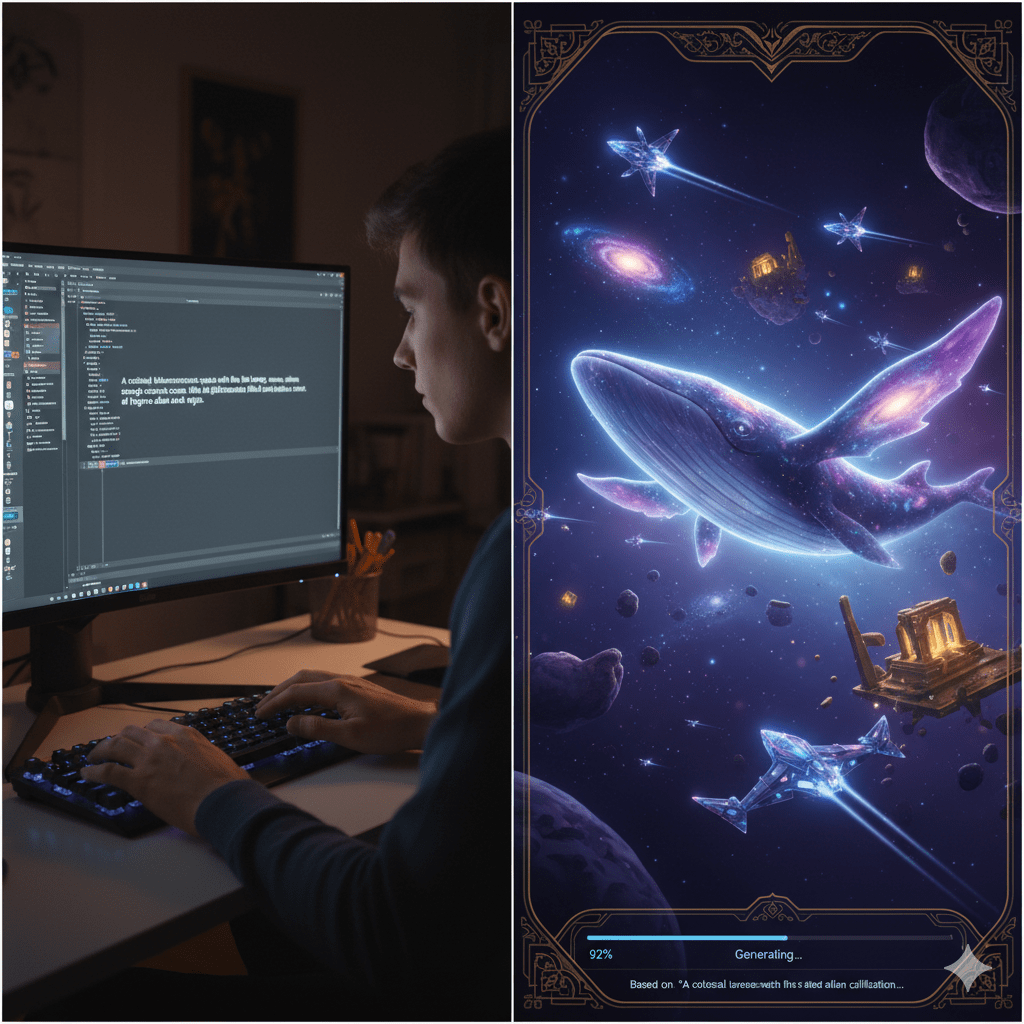Have you ever watched an amazing movie scene—a rocket blasting off to Mars, a golden retriever starting a rock band, or a pirate ship sailing on a sea made of orange soda—and thought, “I wish I could make something like that”?
Well, get ready, because that’s what tools like OpenAI’s Sora are all about. And the magic spell you need to make it work? It’s called a prompt.
Think of AI like a super-smart, super-fast, and super-creative robot artist who’s waiting for your instructions. It can paint, draw, and even make movies, but it can’t read your mind. You have to tell it exactly what you want to see. That instruction is the prompt.
This guide is your secret map. We’re going to explore how to write the perfect prompt for Sora AI 2 (and other amazing tools like it) to turn your wildest ideas into incredible videos. You don’t need to be a tech wizard. You just need your imagination and a few new tricks.
Meet Maya, the Baker with a Big Dream
Let’s imagine a friend named Maya. Maya opens a small, cozy bakery. Her cupcakes are legendary, and her bread is the talk of the town. But here’s the problem: nobody outside her little street knows about it. She needs a commercial, a cool video for social media, but she has no money for a big film crew or fancy actors.
Maya hears about AI video generators like Sora. She gets excited and types in her first prompt:
“A video of my bakery.”
The AI gives her… something. It’s a short, boring clip of a building. It doesn’t show her yummy cookies or the happy customers. It’s not magical. Maya feels stuck.
This is the problem many creators face. The technology is here, but the secret is in the words. This is where human-AI collaboration for creators begins. The AI has the power, but you have the vision.
What is a Sora AI Prompt, Anyway?
Think of a prompt like a recipe for a cake.
If you just write “Make cake,” you might get a plain vanilla square. But if you write, “Make a three-layer chocolate cake with dark chocolate frosting, fresh strawberries on top, and rainbow sprinkles on the sides,” you’re going to get something much better.
A prompt for Sora AI 2 is your detailed recipe for a video. It’s the text you type into the box that tells the AI:
- Who is in the scene (the “actors”)?
- Where is the scene happening (the “set”)?
- What is happening (the “action”)?
- How should it look and feel (the “style”)?
The better your recipe, the better your cake. The better your prompt, the better your video. This is the heart of AI and creativity: you are the director, and the AI is your entire film crew.
How to Write a “Wow” Prompt: Maya’s Second Try
Maya realized her first prompt was a “make cake” recipe. She needed to be the director. So, she sat down and really thought about what she wanted people to feel.
She closed her eyes and imagined her perfect commercial. And, She saw warm, gooey chocolate, happy faces, and her cat, Sprinkles, wearing a tiny chef’s hat.
She tried again. This time, she wrote:
“A close-up, cinematic shot of a warm, gooey chocolate chip cookie being slowly pulled apart. Steam rises from the melted chocolate. In the background, a cozy bakery is softly blurred with warm, glowing lights. A small, fluffy orange cat wearing a tiny white chef’s hat looks on curiously.”
BOOM.
The video Sora created was perfect. It was professional, beautiful, and made you want one of those cookies. It captured the feeling of her bakery. Maya’s video went viral in her town, and soon, she had a line out the door.
She didn’t just get a video; she unlocked a new way to create. This is the future of creative workflow automation. What used to take days, a full crew, and thousands of dollars, Maya did in a few minutes with the right words.
Your 5-Step Guide to Crafting the Best Sora AI Prompts
You can be like Maya. Writing a great prompt for Sora AI 2 isn’t about using big, complicated words. It’s about painting a picture with your words.
Here is a simple, 5-step process.
Step 1: Start with the Subject (The “Who” or “What”)
Be specific. Don’t just say “a man.” Say “a tall, elderly man with a kind face and a white beard, wearing a red flannel jacket.”
- Bad:
A dog - Good:
A fluffy golden retriever puppy
Step 2: Set the Scene (The “Where”)
Where is your subject? What’s in the background? The more detail, the better. This helps the AI understand the world you’re building.
- Bad:
A fluffy golden retriever puppy in a park. - Good:
A fluffy golden retriever puppy sitting on a bright green, sunlit lawn in Central Park, with New York City skyscrapers blurred in the background.
Step 3: Add Action! (The “Doing”)
What is your subject doing? This is a video, so movement is key!
- Bad:
A fluffy golden retriever puppy in a park. - Good:
A fluffy golden retriever puppy, sitting on a bright green, sunlit lawn in Central Park, tilting its head and wagging its tail as a red ball rolls past.
Step 4: Define the “Camera” and Style (The “How”)
This is the secret sauce. How is it being filmed? What does it feel like? Are you watching from far away, or is it an extreme close-up? Is it a cartoon, a real movie, or an old-timey black and white film?
- Bad:
A fluffy golden retriever puppy in a park. - Good:
Cinematic, slow-motion, close-up shot of a fluffy golden retriever puppy sitting on a bright green, sunlit lawn in Central Park, tilting its head and wagging its tail as a red ball rolls past. The shot is bright and cheerful.
Step 5: Add the “Magic” Details
Now, add the final touches that make it special. Think about lighting, weather, and mood.
- Bad:
A fluffy golden retriever puppy in a park. - Best Prompt:
Cinematic, slow-motion, close-up shot of a fluffy golden retriever puppy sitting on a bright green, sunlit lawn in Central Park during the golden hour. The puppy tilts its head and wags its tail as a red ball rolls past. Sunlight filters through the trees, creating a warm, magical glow. The shot is bright, cheerful, and filled with joy.
See the difference? We went from “a dog” to a story.
Real-World Magic: AI and Creativity in Action
This isn’t just for fun (though it is really fun). This human-AI collaboration for creators is changing real jobs.
- Indie Filmmakers: A filmmaker named “Shy Kids” used AI video generation to create a short film called “Air Head.” It tells the story of a man with a balloon for a head. It would have cost a fortune to make with traditional special effects, but they did it with AI, proving that big ideas no longer need a big budget.
- Marketing Teams: Brands are now using AI to create dozens of different versions of their ads in minutes. They can test a version with a red car, one with a blue car, one set in the city, and one in the mountains—all without a single new day of filming. This is creative workflow automation at its best.
- Educators: Imagine a history teacher trying to explain ancient Rome. Instead of just showing a picture, they can type a prompt for Sora AI 2 like, “A realistic, 4K tracking shot following a Roman senator in a white toga as he walks through a bustling, crowded Roman Forum, with the Colosseum visible in the distance.” The past literally comes to life.
Your New AI Toolkit: Tools to Start Creating Today
Sora is the most famous, but it’s not the only tool out there. Here are a few you can explore to start practicing your new prompting skills.
- OpenAI’s Sora: (Not yet public, but it’s the one everyone is watching). It’s known for creating incredibly realistic, long (up to 60 seconds) video clips from a single prompt. Check out OpenAI’s official blog for examples.
- [suspicious link removed]: A fantastic and very popular tool that is available right now. You can create videos from text, images, or even other videos. It’s a favorite for artists and filmmakers.
- Pika: Another powerful text-to-video tool that has gained a lot of attention. It’s great for creating stylish, high-energy clips perfect for social media.
- Midjourney: While this one makes images (pictures), not videos, it’s the absolute best place to practice your prompt-writing skills. Learning to describe a scene in detail for Midjourney will make your video prompts 100 times better.
- Leonardo.AI: This tool is great for both images and, more recently, basic video generation. It’s a fun playground for getting started with creative AI.
The Future Isn’t AI vs. Humans. It’s AI with Humans.
Some people are worried. They ask, “Will AI replace artists, writers, and filmmakers?”
Let’s go back to Maya. Did the AI replace her as a baker? No. Did it replace her as a business owner? No. It helped her. It gave her a new superpower.
The future is all about human-AI collaboration for creators. The AI is a tool, just like a camera or a paintbrush. It can’t have an original idea. Also, It can’t feel emotion. It doesn’t know what makes Maya’s cookies so special.
You are the heart of the creation. Yes, You provide the story, the emotion, and the vision. You write the prompt.
The AI just handles the technical part, the “creative workflow automation” that gets your idea out of your head and onto the screen faster than ever before. This frees you up to spend more time doing what humans do best: dreaming, imagining, and connecting with other people.
Example of Using Roles in Prompt Engineering That Will 10x Your Creativity
Your Turn to Be the Director
The world of AI is moving incredibly fast. A “prompt for Sora AI 2” might seem like science fiction today, but tomorrow it will be as common as sending an email.
You don’t need to be a programmer or a technical genius to be a part of it. And, You just need to be a good storyteller. You need to be human.
So, what’s the first story you’re going to tell? What amazing idea is stuck in your head, just waiting for the right prompt to bring it to life?
Start practicing. Open a tool. And write your first prompt.
A Writing Prompt Is the Only Tool You Need to Unlock AI’s “Magic”—Here’s Why



